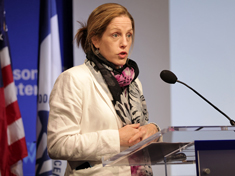-
Alice Thomas: For Refugees, Environmental Recovery Critical for Return to Normalcy
July 11, 2014 By Moses Jackson
There are now well over 16 million refugees worldwide and 65 million people internally displaced by conflict and disasters, according to recent estimates. As more and more people are uprooted from their homes, mounting environmental pressures threaten to reinforce cycles of poverty and displacement if left unaddressed, says Alice Thomas in this week’s podcast.
There are now well over 16 million refugees worldwide and 65 million people internally displaced by conflict and disasters, according to recent estimates. As more and more people are uprooted from their homes, mounting environmental pressures threaten to reinforce cycles of poverty and displacement if left unaddressed, says Alice Thomas in this week’s podcast.
“If you’re not following this very closely, a lot of people just think that refugees live in camps and have images of people behind fences,” says Thomas, the climate displacement program manager at Refugees International. “Actually most refugees do not live in camps; they reside with host families and host communities, and increasingly they live in cities.”
“Most refugees do not live in camps; they reside with host families and host communities”The ability of displaced people to recover from crises is often hindered by lack of access to natural resources that would otherwise provide them with livelihoods, food, and water, says Thomas. Her research shows that people’s decisions to resettle or return to their areas of origin hinge on whether they have a means to make a living. Environmental recovery is therefore critical for creating long-term, “durable solutions” to displacement – as well as addressing some of the immediate “protection risks” that plague camp settings, many of which stem from resource scarcity, Thomas says.
Planning for the Short and Long Term
“The international humanitarian system is fairly good at handing out aid,” says Thomas, “but it’s gotten much more important to think about how to get people off of aid and living independently.”
Many responses to international crises are constrained by rigid sectoral funding and a lack of coordination between different sectors and organizations, she says. Donors tend to prioritize life-saving assistance over other interventions, and shorter-term humanitarian efforts are often disconnected from longer-term development efforts.
“It’s gotten much more important to think about how to get people off of aid and living independently”A broader focus on “resilience” can facilitate greater integration, Thomas says, “whether you like that word or not.” Pooling funding, as opposed to keeping it narrowly focused on specific outcomes, allows projects to simultaneously address both immediate concerns, such as drought-induced food shortages, as well as long-term concerns, such as the need for improved farming practices. “This is, in my experience, a positive development…It’s an opportunity to start taking a more holistic approach toward the response,” she says.
Building Self-Reliance
One avenue for incorporating environmental programming into crisis response is through the “self-reliance” approach adopted by the UN Refugee Agency’s latest Global Strategy for Livelihoods, which aims to reduce the dependency of displaced people rather than “teach them to make soap or sell snacks.” The strategy provides an opportunity for environmental actors to get involved early on, says Thomas, and begin “restoring the environment on which refugees and other people rely.”
Other opportunities for integration can be found in cities, where humanitarian efforts must address not only growing numbers of displaced people but also a growing number of conflicts and disasters, says Thomas:
It doesn’t make sense in urban environments…to just have a sector approach that looks at food, sanitation, and shelter. You’re seeing a response that looks at the urban challenges as a whole and talks about what they call ‘neighborhood coherence’ as opposed to ‘sector coherence.’
A case in point is the recovery and rehabilitation plan adopted by the Philippines’ Tacloban City after Typhoon Haiyan, says Thomas. “It looks at the need to not just restore some of the environmental damage that was done…but it takes the opportunity from the storm to actually re-zone a lot of the city and figure out where people should live.” Rather than simply creating no-build zones in disaster-prone areas, which prolongs displacement, she says, the plan takes a holistic approach to resilience and encourages decision-makers to consider a diversity of possibilities, including the relocation of the airport, for instance.
The success of such plans is largely a matter of political will, Thomas says. “It’s not enough for the international community to come in and say ‘this is what you need to do’; you need to have the municipalities themselves wanting to take on urban challenges in this way.”
Thomas spoke at the Wilson Center on June 25. Download her slides to follow along.
Friday podcasts are also available for download on iTunes.
Sources: Internal Displacement Monitoring Center, UN High Commissioner for Refugees.
Topics: climate change, conflict, conservation, demography, development, disaster relief, environment, environmental health, environmental security, flooding, food security, forests, Friday Podcasts, funding, humanitarian, livelihoods, migration, natural resources, Philippines, podcast, population, risk and resilience, security, urbanization
 A Publication of the Stimson Center.
A Publication of the Stimson Center.







